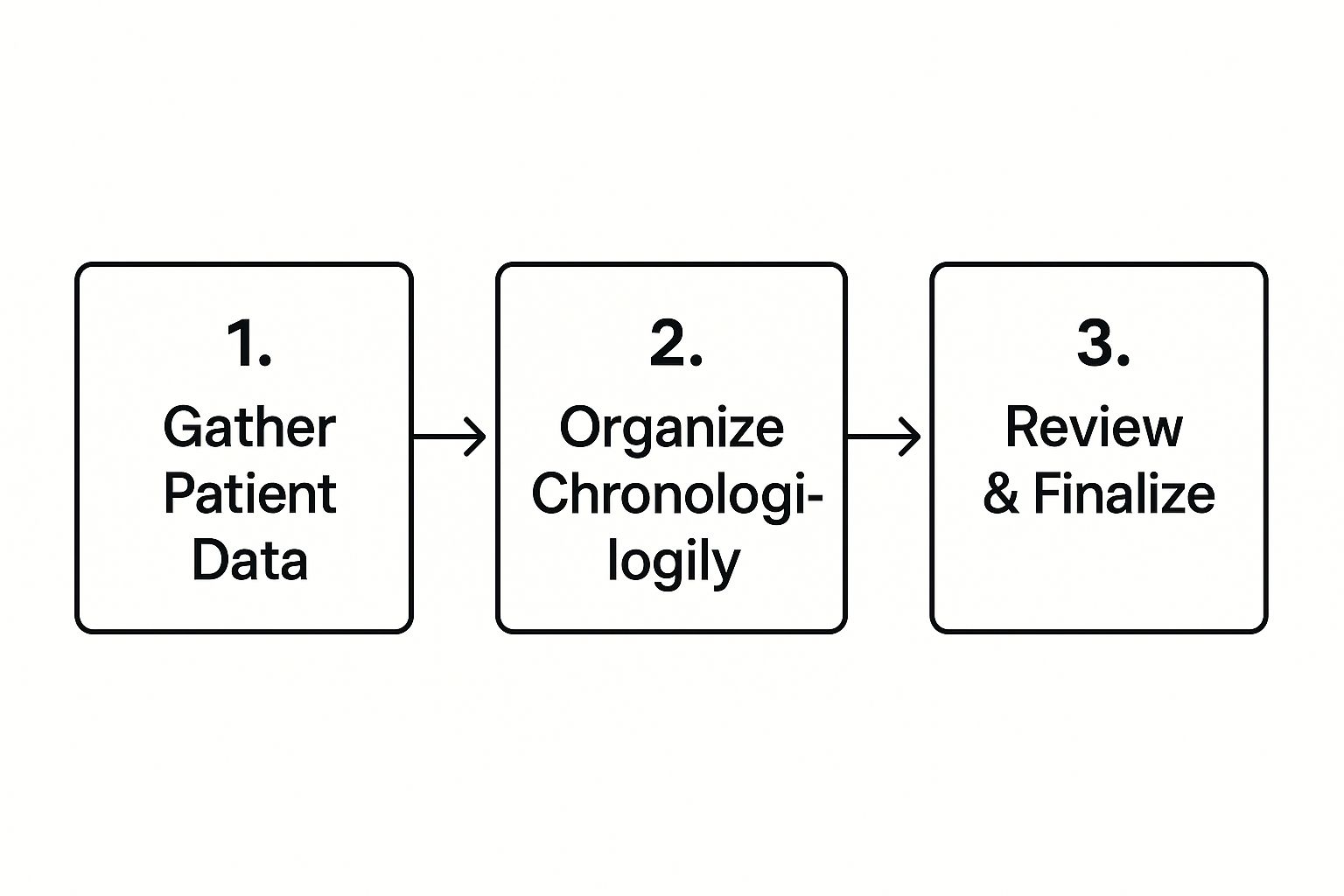Other Blogs
Check out other Legal AI Posts

Discover how to build a powerful medical chronology template for personal injury cases. Get expert tips, avoid common mistakes, and learn to win.

A medical chronology template is a game-changer for personal injury cases. Think of it as a structured document that takes a patient's entire medical history and organizes it into a clean, chronological timeline.
Instead of drowning in stacks of complex medical records, you get a clear, easy-to-follow story. It highlights every key event, treatment, and provider, making it an indispensable tool for building a winning case.
Let's be honest: a mountain of medical records can easily bury the truth. A well-crafted medical chronology cuts right through that clutter, turning dense, confusing files into a persuasive narrative that adjusters, judges, and juries can actually understand.
This isn't just about listing dates. It’s about shaping the story that becomes the backbone of your entire legal strategy.

Picture a typical multi-car accident. Your client saw an ER doctor, their primary care physician, an orthopedic specialist, and a physical therapist over the course of six months. Without a chronology, you're stuck with four different sets of records, all with overlapping dates and conflicting notes. It’s a mess.
A sharp, organized chronology brings order to that chaos. It creates a single, unified timeline that clearly shows the progression of injuries, the consistency of treatment, and the undeniable link between the accident and the medical care they received.
A powerful chronology does more than just organize—it tells the story. By laying out every single event in sequence, you can instantly spot critical patterns and facts that make your case stronger.
For example, a chronology might reveal that a patient's complaints of headaches began only after a specific physical therapy session, a detail that might be lost across different provider records but becomes obvious in a unified timeline.
This approach is really just a modern take on a practice that’s been around for centuries. The first medical charts appeared around 4,000 years ago as simple records of symptoms. Today’s templates are obviously far more detailed, capturing everything from the date of injury and diagnosis to physician details and recovery progress, all while staying compliant with privacy laws.
Of course, a robust medical chronology is only as good as the data you feed it. For anyone working with medical records, understanding the importance of accurate medical healthcare transcription is fundamental. This precision is what allows the chronology to serve its true purpose.
A meticulously prepared chronology can:
Ultimately, a detailed chronology makes even the most complex medical histories understandable and compelling. The process has been made even easier with modern tools, and you can learn more about https://www.proplaintiff.ai/post/harnessing-ai-for-medical-chronologies-in-personal-injury-cases.
Alright, let's get hands-on. A powerful medical chronology starts with a smart, well-designed template. You don’t need fancy software—a simple tool like Microsoft Excel or Google Sheets is all it takes to build a flexible framework that you can adapt to any personal injury case.
The real goal here is to move beyond a simple list of dates. We're building a dynamic tool that helps you uncover the story hidden inside those stacks of medical records. When you start building, thinking about best practices for creating effective template structures can make a huge difference in clarity and usability down the line.

This structure isn't just about staying organized; it actively improves the quality of your work. Using a consistent template for medical records is proven to cut down on mistakes and speed up the entire documentation process. In fact, a study published in the Journal of Medical Internet Research found that using templates in electronic health records significantly improves the completeness of documentation. This principle directly applies to legal chronologies, enhancing both speed and accuracy.
Think of these columns as the absolute non-negotiables. They are the foundation of your template, capturing the essential "who, what, when, and where" of the client's medical journey. Without these, your timeline will lack the basic details needed to be credible.
At a minimum, your template should always include:
These basic fields ensure that anyone—an attorney, an adjuster, or a juror—can quickly get the gist of the case's timeline.
With a well-designed template in hand, you’re ready to shift from planning to doing. This is where you transform a chaotic pile of medical records into a coherent, powerful narrative that tells your client's story.
Don't let the stack of documents intimidate you. Adopting a systematic workflow is the secret to making this process accurate, efficient, and far less daunting.
The whole process boils down to three core steps: Gather, Organize, and Review. Think of it as your North Star for maintaining order and consistency.

This simple flow is your foundational guide. It helps prevent errors and ensures no critical piece of information gets lost in the shuffle.
Your first pass should be a broad sweep. The goal here isn't detail; it's structure. Focus on getting every single record into the template in the correct date order. Start with the foundational documents—like the initial incident report or the first ER visit—and build your timeline from there.
The best place to begin is by getting your hands on all the initial medical records. A quick interview with the client can help you map out every healthcare provider they saw right after the incident. From there, you can start requesting the files you'll need, which almost always include:
Resist the urge to summarize or editorialize at this stage. Your only goal right now is to transfer the core facts—date, provider, record type, and Bates number—into your template. This creates a chronological skeleton that will form the backbone of your entire document.
Once that skeleton is built, you can move on to the next pass: summarizing. This is where the real work happens. You’ll be distilling dense medical jargon from multi-page documents, like surgical reports or physical therapy logs, into clear, objective statements. The key is to capture the essence of the event without injecting your own opinions.
For instance, a complicated surgical report might get summarized like this: "Surgical intervention: L4-L5 discectomy. Surgeon Dr. Evans noted significant nerve root compression during the procedure. Patient discharged with a prescription for Oxycodone and instructions for limited mobility for 4 weeks."
A crucial part of this process is identifying and flagging potential issues as you go. Make a note of any missing records, illegible handwriting, or conflicting information between two providers. A dedicated 'Notes' or 'Flags' column in your template is perfect for this.
This methodical approach ensures every detail is captured accurately. While this process has always been time-consuming, new tools are changing the game. For a deeper look, check out our guide on creating a personal injury medical chronology with AI assistance.
Throughout the entire data entry process, your guiding principle must be objectivity. The chronology’s power comes from its factual accuracy, not your interpretation of the facts. Steer clear of interpretive language like "the patient was in excruciating pain."
Instead, quote the record directly: "Patient reported pain level as 9/10." Let the facts speak for themselves.
Here are a few professional tips for keeping things consistent:
Once you’ve filled in your medical chronology template, you’ve done more than just organize data—you’ve built the foundation of your case narrative. A completed chronology is an incredibly powerful asset, but its real magic happens when you shift from just listing facts to telling a story that clicks with adjusters, mediators, and eventually, a jury.
The goal is to connect the dots. You need to show, clearly and directly, how the initial incident led to a cascade of treatments, expenses, and a profound change in your client's life. A strong chronology does this visually and textually, making the arguments for causation and damages impossible to ignore.

This need for clear, portable medical histories isn't just a legal quirk; it’s a global trend. The demand for standardized medical chronologies actually grew with the rise of international travel, as people needed accessible health records. This was supercharged by mobile tech—with about 85% of the world's population covered by wireless signals, digital records became the obvious solution. If you want to dive deeper, you can read the full research about the evolution of mobile health records.
Your spreadsheet holds the facts, but the narrative summary is where you interpret them. This is a concise, written overview that guides the reader through the most critical events, drawing explicit lines between them and your legal claims. It's your chance to control how the facts are understood.
For instance, a summary might start like this: "Following the collision on March 15, 2024, the plaintiff immediately sought emergency care for severe neck pain. As the chronology shows, this single injury directly led to three months of physical therapy, a cervical spine MRI revealing a herniated disc at C5-C6, and finally, a recommendation for surgery—a treatment path completely absent from her pre-incident medical history."
Never, ever underestimate the power of a good visual. A clean timeline or chart can make a complex medical history understandable in seconds, something dense paragraphs of text just can't do. Modern spreadsheet software makes it ridiculously easy to turn your chronology data into persuasive exhibits for demand letters, mediations, or trial.
Try creating these visuals directly from your data:
By transforming your data into these formats, you make the client’s experience tangible. A timeline showing a year of continuous treatment is far more impactful than just saying "the client received extensive care."
A client’s life doesn't stop and start at the clinic door. To paint the full picture of their damages, you have to bring in the real-world context. Adding a few extra columns to your medical chronology template for these details can make your narrative so much richer.
Be sure to include entries for:
Taking this holistic approach turns your chronology from a dry clinical record into the persuasive story of a life interrupted. It makes the case for damages both undeniable and deeply human.
A well-built medical chronology is one of your most powerful assets, but it's only as strong as its weakest link. A few preventable errors can quickly undermine its credibility, giving opposing counsel exactly the ammunition they need to poke holes in your case narrative.
Think of your chronology as a foundational legal document. Any error isn't just a typo; it's an invitation for doubt. To keep your case on solid ground, you have to be aware of common legal document mistakes and actively work to avoid them, especially when you're laying out the medical timeline.
This is probably the most damaging mistake you can make. It’s easy to inject personal interpretation or emotional spin into an event summary, but the chronology’s power comes from its pure objectivity. It needs to reflect exactly what the medical records state, not what you think they imply.
See the difference? The corrected version lets the facts speak for themselves, preserving the document's integrity. Always stick to direct quotes or neutral summaries from the provider's notes. Our guide on how to create accurate medical chronology reports for demand letters dives even deeper into keeping your summaries clean and factual.
It's tempting to focus only on the big stuff—hospital reports, specialist consults—but a truly comprehensive timeline includes every piece of the puzzle. Skipping certain records creates what look like "gaps in treatment," a favorite talking point for defense attorneys trying to argue the injuries weren't that severe.
A classic example is when a client can't get a specialist appointment for six weeks. To the defense, that's a gap. But a detailed chronology will show every pharmacy refill, every phone call to the doctor's office, and every attempt to manage pain during that period, proving the client was actively seeking care.
Your record requests need to be exhaustive. Make sure you're pulling:
Never underestimate the danger of skipping a final, dedicated review. After hours spent deep in the weeds of data entry, your brain starts to auto-correct. You become blind to your own mistakes, whether it's a simple typo or a transposed date that throws off the entire timeline.
Before you call it done, have a fresh pair of eyes—a colleague, another paralegal—review the entire chronology against the source documents. This simple "pre-flight check" is non-negotiable. A study from the Journal of the American Medical Informatics Association highlighted that peer review processes can significantly reduce data abstraction errors in medical records, reinforcing the value of this step. It ensures your work is accurate, defensible, and ready to serve as the unshakeable foundation of your client's case.
When you're buried in the details of a personal injury file, a few common questions about medical chronologies always seem to surface. Let's get them answered.
Sooner or later, you'll find records that don't match. An ER report says "left ankle," but the orthopedic follow-up says "right ankle." Don't just pick one and hope for the best.
The only way to handle this is with complete transparency. You need to log both entries in your chronology, creating a separate line item for each conflicting piece of information. Critically, make sure you cite the source for each one (the Bates number is perfect for this).
A simple "Notes" or "Discrepancy" column is your best friend here. For example, you might write: "Conflict: ER record (ABC-0012) notes injury to 'left ankle,' while Dr. Smith's initial consult (XYZ-0003) notes 'right ankle.' Needs clarification." Flagging the conflict makes it impossible for the legal team to miss, allowing them to address it head-on during discovery instead of being blindsided later.
This approach preserves the integrity of your timeline and turns a potential problem into a strategic point of clarification.
Honestly, for most firms, you don't need to overcomplicate it. Your go-to tools are likely the best: Microsoft Excel or Google Sheets.
These spreadsheet programs are incredibly powerful, flexible, and—most importantly—everyone knows how to use them. You can sort, filter, and customize every single column to fit the unique facts of your case.
While there's plenty of dedicated legal software out there, a well-built spreadsheet template gives you total control. As this guide on preparing chronology reports points out, you're never locked into a rigid system that doesn't quite fit the case you're working on today.
Yes, one hundred percent. A column for "Billed Amount" or "Cost of Service" isn't just helpful—it's essential.
This data is the foundation for calculating medical special damages. By logging the cost right next to the corresponding service, you create a clean, direct line between a specific treatment and its financial cost.
For example, an entry for "MRI of lumbar spine" might have a corresponding billed amount of "$2,850." Doing this from the start makes tallying up the total damages for the demand letter infinitely easier and provides clear justification for the settlement figure you're aiming for.
Ready to stop wrestling with stacks of medical records and start building winning case narratives? ProPlaintiff.ai uses advanced AI to create precise medical chronologies, demand letters, and case summaries in a fraction of the time. Transform your workflow and focus on what matters most—your clients. See how ProPlaintiff.ai can work for your firm.
Check out other Legal AI Posts
